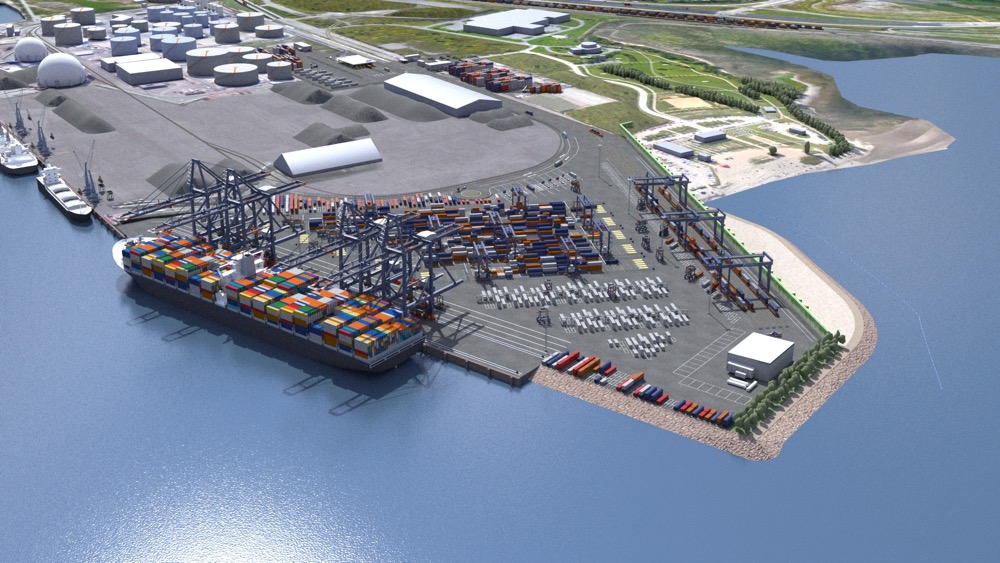By Leo Ryan, Editor
The Port of Québec has challenged certain major issues raised last week in a federal agency report which concluded that the planned Laurentia container terminal project in its present form “is likely to cause significant adverse environmental effects.” In its draft report, the Impact Assessment Agency of Canada affirmed that various mitigation measures proposed by the project’s proponents to minimize adverse residual and other effects are insufficient.
Public comments on the project can be received until December 16. The final report will subsequently be submitted to the Minister of Environment and Climate Change. And the formal federal government verdict is expected sometime in the first quarter of 2021.
The project entails a joint investment of $775 million by Hutchison Ports, CN and the Port of Québec to build what is billed as the greenest deepwater container terminal in North America – opening a new maritime corridor between Southeast Asia and the Port of Quebec as of 2024.
In its comments, the agency referred to “significant direct and cumulative residual adverse environmental effects on fish and fish habitat, even with the application of mitigation, monitoring, compensation and follow-up measures.”
It pointed to “significant direct and cumulative residual environmental effects on air quality and human health due to increased emissions of particulate matter and contaminants from fossil fuel combustion during both the construction and operational phases of the terminal in an environment previously saturated with airborne contaminants.”
The interim report singled out adverse environmental effects on the current use of lands and resources for traditional purposes, especially fishing activities as well as on sports and commercial fisheries.
Responding to the IAAC report, Mario Girard, President and CEO of the Québec Port Authority, declared: “Unfortunately the IAAC interim report ignores important facts about fish and fish habitat and presents an inaccurate and misleading reading of air quality issues and data. In addition, the report does not take into consideration much of the information we submitted to provide a more complete picture of the project’s potential impact. It’s very unfortunate. We hope that the next steps in the current evaluation process will help correct this situation.”
Among other matters raised, the Port of Québec indicated that with the help of experts QPA has acquired considerable knowledge of fish and fish habitat over the past seven years. Rigorous studies incorporating telemetric monitoring have provided information on the behaviour and habits of fish populations.
Based on these analyses, it is now known that lake and Atlantic sturgeon are found in the St. Charles River Estuary, and not in the Beauport Bay area.
“QPA is also surprised that the Agency does not take into account the fact that the Committee on the Status of Endangered Wildlife in Canada (COSEWIC) ruled in 2019 that the striped bass reintroduced into the St. Lawrence in the early 2000s could not be considered the same species as the one that disappeared before. And that the status of the striped bass currently present in the St. Lawrence River, which was upgraded to “endangered” in 2012 from “extirpated” in 2004, therefore needed to be reviewed.”
“Furthermore, telemetric analyses conducted over 4 years determined that the striped bass spawning area was much larger than initially estimated, covering 280 hectares. Thus the new terminal will have a limited impact on overall striped bass breeding.”
The port further asserts that “Laurentia will have a limited impact on truck traffic, which is estimated to increase by 7% on Boulevard Henri-Bourassa once the terminal is fully operational around 2035. In order to eliminate this impact, QPA has been advocating since January 2020 for use of a voluntary bypass route on the highway network, and is today asking the City of Québec and the Ministry of Transport to make use of this route mandatory for all trucks.”
Once the terminal is at full capacity in 2035, some 90% of the 700,000 containers transiting there will be transported by train – the core business model. “With the exception of the Prince RUPERT Terminal in western Canada, far fewer trucks will be used at Laurentia to transport containerized goods than at other North American terminals.”
Among other comments, the Port of Québec noted that since 2015 it has introduced several changes to initial plans in response to concerns from public and various groups. This has resulted in removing 24 hectares from the project, or 53% from the original plan.
Finally, the port underlined “long-term benefits that make it much more than a mere container terminal” – a logistics hub on the South Shore, a springboard for hundreds of companies in the region that import and export, and a catalyst showcasing Quebec research institutions and innovative companies. (Photo is artist rendering from Port of Québec)





